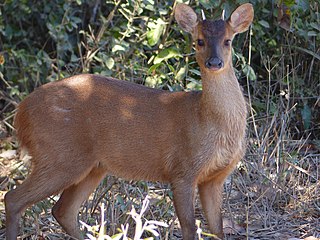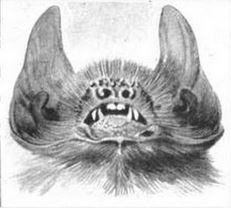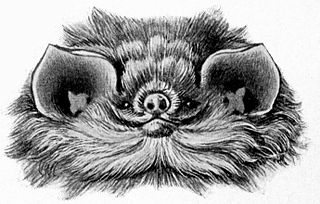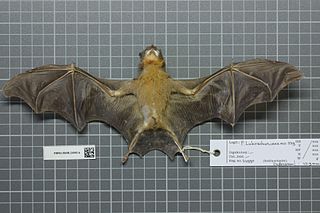 W
WThe red-rumped agouti, also known as the golden-rumped agouti, orange-rumped agouti or Brazilian agouti, is a species of agouti from the family Dasyproctidae. It is native to northeastern South America, where found in Venezuela, Guyana, Suriname, French Guiana, northeastern Brazil, and Trinidad and Tobago. It has also been introduced to the U.S. Virgin Islands, Grenada, and Dominica. Despite the alternative name Brazilian agouti, it is neither the only nor the most widespread species of agouti in Brazil. In Brazil all agoutis are often called "cutia" [kuˈtʃiɐ].
 W
WThe silky anteater, also known as the pygmy anteater, has traditionally been considered a single species of anteater, Cyclopes didactylus, in the genus Cyclopes, the only living genus in the family Cyclopedidae. Found in southern Mexico, and Central and South America, it is the smallest of all known anteaters. It has nocturnal habits and appears to be completely arboreal; its hind feet are highly modified for climbing.
 W
WThe nine-banded armadillo, or the nine-banded, long-nosed armadillo, is a medium-sized mammal found in North, Central, and South America, making it the most widespread of the armadillos. Its ancestors originated in South America, and remained there until the formation of the Isthmus of Panama allowed them to enter North America as part of the Great American Interchange. The nine-banded armadillo is a solitary, mainly nocturnal animal, found in many kinds of habitats, from mature and secondary rainforests to grassland and dry scrub. It is an insectivore, feeding chiefly on ants, termites, and other small invertebrates. The armadillo can jump 3–4 ft (91–122 cm) straight in the air if sufficiently frightened, making it a particular danger on roads. It is the state small mammal of Texas.
 W
WThe desert red bat, also known as the western red bat or southern red bat is a species of microbat found across the Americas. Lasiurus blossevillii is most often found in tree foliage, as is most in the genus Lasiurus, and is a solitary species.
 W
WThe southern yellow bat is a species of vesper bat that belongs to suborder microchiroptera (microbat) in the family Vespertilionidae. It is native to South, North and Central America, from the Rio Grande Valley of Texas in the United States to Argentina.
 W
WThe common vampire bat is a small, leaf-nosed bat native to Latin America. It is one of three extant species of vampire bat, the other two being the hairy-legged and the white-winged vampire bats. The common vampire bat practices hematophagy, mainly feeding on the blood of livestock. The bat usually approaches its prey at night while they are sleeping. It then uses its razor-sharp teeth to cut open the skin of its hosts and lap up their blood with its long tongue.
 W
WThe Brazilian porcupine is a porcupine found in Brazil, Argentina, Colombia, Venezuela, Guyana, French Guiana, Peru, Paraguay, Suriname, Bolivia and Trinidad, with a single record from Ecuador. It inhabits tropical forests at elevations up to 1500 m.
 W
WThe red brocket is a species of brocket deer from forests in South America, ranging from northern Argentina to Colombia and the Guianas. It also occurs on the island of Trinidad in the Republic of Trinidad and Tobago.
 W
WThe Brown weeper capuchin or Venezuelan brown capuchin is a species of gracile capuchin monkey from Venezuela.
 W
WThe tufted capuchin, also known as brown capuchin, black-capped capuchin, or pin monkey is a New World primate from South America. As traditionally defined, it is one of the most widespread primates in the Neotropics, but it has recently been recommended considering the black-striped, black and golden-bellied capuchins as separate species in a new genus, thereby effectively limiting the tufted capuchin to the Amazon basin and nearby regions.
 W
WWhite-fronted capuchin can refer to any of a number of species of gracile capuchin monkey which used to be considered as the single species Cebus albifrons. White-fronted capuchins are found in seven different countries in South America: Bolivia, Brazil, Colombia, Venezuela, Ecuador, Peru, and Trinidad and Tobago.
 W
WThe capybara is a giant cavy rodent native to South America. It is the largest living rodent in the world. Also called capivara, chigüire, chigüiro, or fercho, carpincho and ronsoco, it is a member of the genus Hydrochoerus, of which the only other extant member is the lesser capybara. Its close relatives include guinea pigs and rock cavies, and it is more distantly related to the agouti, the chinchilla, and the coypu. The capybara inhabits savannas and dense forests and lives near bodies of water. It is a highly social species and can be found in groups as large as 100 individuals, but usually lives in groups of 10–20 individuals. The capybara is not a threatened species, but it is hunted for its meat and hide and also for grease from its thick fatty skin.
 W
WThe common opossum, also called the southern or black-eared opossum or gambá, and sometimes called a possum, is a marsupial species living from the northeast of Mexico to Bolivia, including Trinidad and Tobago, where it is called manicou. It prefers the woods, but can also live in fields and cities.
 W
WThe crab-eating raccoon or South American raccoon is a species of raccoon native to marshy and jungle areas of Central and South America. It is found from Costa Rica south through most areas of South America east of the Andes down to northern Argentina and Uruguay. Despite its name, this species is not restricted to eating only crabs, and the common raccoon also seeks and eats crabs where they are available.
 W
WDavy's (lesser) naked-backed bat is a small, insect-eating, cave-dwelling bat of the Order Chiroptera and Family Mormoopidae. It is found throughout South and Central America, including Trinidad, but not Tobago, Guyana, Suriname, or French Guiana. Specimens of this bat had been found infected with rabies in Trinidad during the height of that's island's vampire-bat transmitted rabies epidemic of the early half of the 20th century, but not in recent times.
 W
WThe dusky slender opossum is a species of opossum in the family Didelphidae. It is found in Colombia, Trinidad and Tobago, and Venezuela. It is threatened by habitat loss.
 W
WThe fringe-lipped bat is a leaf-nosed bat from southern Mexico to Bolivia and southern Brazil. It has three subspecies and no known fossils. It is the only species within its genus.
 W
WThe Guyanan red howler is a species of howler monkey, a type of New World monkey, native to Suriname, Guyana, Trinidad, French Guiana, Venezuela and Brazil.
 W
WThe Javan mongoose or small Indian mongoose is a mongoose species native to South and Southeast Asia that has also been introduced to many regions of the world.
 W
WThe lowland paca, also known as the spotted paca, is a large rodent found in tropical and sub-tropical America, from east-central Mexico to northern Argentina, and has been introduced to Cuba and Algeria.
 W
WThe ocelot is a wild cat native to the southwestern United States, Mexico, and Central and South America, as well as the Caribbean islands of Trinidad and Margarita. This medium-sized cat is characterized by solid black spots and streaks on its coat, round ears, and white neck and undersides. It weighs between 8 and 15.5 kg and reaches 40–50 cm at the shoulders. It was first described by Carl Linnaeus in 1758. Two subspecies are recognized: L. p. pardalis and L. p. mitis.
 W
WOecomys trinitatis, also known as the long-furred oecomys, long-furred rice rat, Trinidad arboreal rice rat, or big arboreal rice rat, is a species of rodent in the genus Oecomys of family Cricetidae. As currently constituted, it has a wide distribution in Central America and South America, being found in southern Costa Rica, Panama, Colombia, Venezuela, Trinidad and Tobago, Guyana, Suriname, French Guiana, much of Brazil, eastern Ecuador, and eastern Peru. It may in fact include more than one species.
 W
WThe bare-tailed woolly opossum is an opossum from South America. It was first described by Swedish zoologist Carl Linnaeus in 1758. The bare-tailed woolly opossum is characterized by a gray head, brown to gray coat, orange to gray underside and a partially naked tail. It is nocturnal and solitary; there is hardly any social interaction except between mother and juveniles and in mating pairs. The opossum constructs nests in tree cavities, and its litter size ranges from one to seven. Gestation lasts 25 days, and the juveniles exit the pouch after three months; weaning occurs a month later. The bare-tailed woolly opossum inhabits subtropical forests, rainforests, secondary forests, and plantations; its range extends from northern Venezuela to northeastern and southcentral Brazil. The IUCN classifies this opossum as least concern.
 W
WThe neotropical otter or neotropical river otter is an otter species found in Central America, South America and the island of Trinidad. It is physically similar to the northern and southern river otter, which occur directly north and south of this species' range. The length of the neotropical otter can range from 36–66 centimetres (14–26 in), plus a tail of 37–84 centimetres (15–33 in). Body weight ranges from 5–15 kilograms (11–33 lb). Otters are members of the family Mustelidae, the most species-rich family in the order Carnivora.
 W
WThe collared peccary is a species of mammal in the family Tayassuidae found in North, Central, and South America. They are commonly referred to as javelina, saíno, or báquiro, although these terms are also used to describe other species in the family. The species is also known as the musk hog. In Trinidad, it is colloquially known as quenk.
 W
WThe red-tailed squirrel is a largish tree squirrel distributed from southern Central to northern South America.
 W
WThe spectral bat, also called the great false vampire bat or Linnaeus's false vampire bat, is a large, carnivorous leaf-nosed bat found in Mexico, Central America, and South America. It is the only member of the genus Vampyrum; its closest living relative is the big-eared woolly bat. It is the largest bat species in the New World, as well as the largest carnivorous bat: its wingspan is 0.7–1.0 m (2.3–3.3 ft). It has a robust skull and teeth, with which it delivers a powerful bite to kill its prey. Birds are frequent prey items, though it may also consume rodents, insects, and other bats.
 W
WThe southern tamandua, also called the collared anteater or lesser anteater, is a species of anteater from South America. It is a solitary animal, found in many habitats from mature to highly disturbed secondary forests and arid savannas. It feeds on ants, termites, and bees. Its very strong fore claws can be used to break insect nests or to defend itself.
 W
WThe tayra is an omnivorous animal from the weasel family, native to the Americas. It is the only species in the genus Eira.
 W
WThe thumbless bat is a species of insectivorous bat in the family Furipteridae, in the monotypic genus Furipterus. It is found in Costa Rica, Brazil, Venezuela; Colombia; Ecuador; Suriname; French Guiana; Guyana; Panama; Trinidad, and Peru. They have a small thumb which is included in the membrane of the wing, causing the 'thumbless' appearance.
 W
WThe Trinidad spiny pocket mouse is a species of rodent in the family Heteromyidae. It is found in Colombia, Trinidad and Tobago, and Venezuela.
 W
WThe Trinidad spiny rat is a species of rodent in the family Echimyidae. It is found in Trinidad and Tobago and northern Venezuela.
 W
WThe Trinidadian funnel-eared bat is a species of bat in the family Natalidae. It is endemic to Colombia, Venezuela, Guyana, Suriname, French Guiana, Trinidad and Tobago and Netherlands Antilles.
 W
WVampire bats, species of the subfamily Desmodontinae, are leaf-nosed bats found in Central and South America. Their food source is blood, a dietary trait called hematophagy. Three extant bat species feed solely on blood: the common vampire bat, the hairy-legged vampire bat, and the white-winged vampire bat. All three species are native to the Americas, ranging from Mexico to Brazil, Chile, Uruguay and Argentina.
 W
WThe West Indian manatee or "sea cow", also known as North American manatee, is the largest surviving member of the aquatic mammal order Sirenia. It is further divided into two subspecies, the Florida manatee and the Antillean or Caribbean manatee, based on genetic and morphological studies. The Florida subspecies is primarily found along the coasts of Florida, but its range extends as far west as Texas and as far north as Massachusetts. The Antillean subspecies has a sparse distribution throughout the Caribbean, ranging as far north as Mexico and as far south as Brazil.
 W
WThe yellow-throated big-eared bat or orange-throated bat(Lampronycteris brachyotis) is a species of bat from South and Central America, where it ranges from southern Mexico to Brazil. It is monotypic within the genus Lampronycteris. A frugivore and insectivore, it is found in lowland forest up to an elevation of 700 m. Its activity is greatest in the first two hours after sunset, and peaks again after midnight.